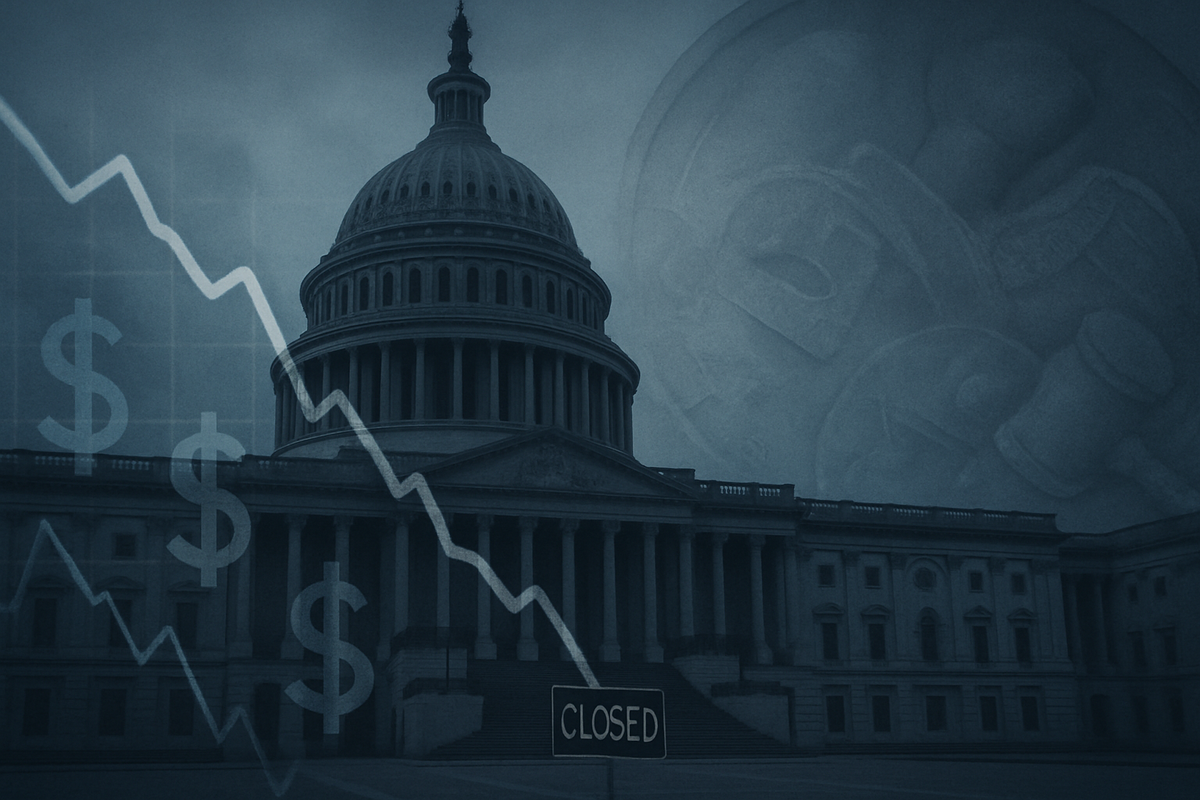
The United States government is currently in the throes of its third week of a shutdown, a fiscal impasse that commenced on October 1, 2025, following a congressional failure to enact appropriations legislation for the 2026 fiscal year. This eleventh government shutdown in U.S. history is sending ripples of uncertainty through the economy, delaying crucial economic data, and forcing the Federal Reserve to navigate a fog of incomplete information. Against this backdrop, Fed Chair Jerome Powell delivered a highly anticipated speech on October 14, 2025, acknowledging the economic headwinds and signaling potential further interest rate cuts, even as the shutdown obscures the full picture.
The ongoing stalemate is a direct consequence of deep-seated partisan disagreements over federal spending levels, the rescission of foreign aid, and contentious health insurance subsidies, particularly the extension of Affordable Care Act (ACA) tax credits. As hundreds of thousands of federal employees face furloughs or work without pay, and essential government services are curtailed, the nation watches anxiously for a resolution that remains elusive. The immediate implications for GDP growth, consumer confidence, and the financial markets are significant, complicating the Federal Reserve's delicate task of steering monetary policy.
A Nation on Hold: Unpacking the Third Week of Government Closure
The current government shutdown, now in its third week as of October 14, 2025, represents a critical juncture for the U.S. economy. The genesis of this fiscal crisis lies in the inability of Congress to pass the necessary appropriations bills for the 2026 fiscal year by the September 30 deadline. The House of Representatives, predominantly Republican, passed a funding measure on September 19, but the Senate, where Democrats hold sway, has been unable to secure the 60 votes required to advance the House bill, largely due to demands for extensions of health insurance tax credits. This partisan gridlock has left approximately 900,000 federal employees furloughed and another 700,000 working without compensation, creating immediate financial distress for millions of American families.
The timeline of events saw the shutdown officially begin on October 1st. By October 12th, prominent institutions like the Smithsonian museums, research centers, and the National Zoo had ceased operations. While essential services such as Medicare, Medicaid, and the Transportation Security Administration (TSA) continue, the broader impact is significant. The Office of Management and Budget (OMB) under the Trump administration has even announced continued permanent cuts to the federal workforce, adding a layer of severity not always present in past shutdowns. Federal courts, though operating on non-appropriated funds, have warned of potential reductions in essential functions if the shutdown extends beyond mid-October.
Key players in this unfolding drama include the President, whose administration is navigating the operational challenges and workforce decisions; the Republican-led House, which passed its funding bill; and the Democrat-led Senate, which has blocked the House measure over policy disagreements. Initial market reactions have been somewhat muted, with U.S. Treasuries rallying (yields falling) as investors price in concerns about weaker economic growth rather than immediate credit risk. However, the delay of crucial economic data, including the U.S. jobs report and the Consumer Price Index (CPI) report, by a largely shut-down Bureau of Labor Statistics (BLS), poses a significant challenge for policymakers and investors alike, creating an opaque environment for economic assessment.
Fed Chair Jerome Powell, in his October 14, 2025 speech on the "Economic Outlook and Monetary Policy" at the National Association for Business Economics (NABE) Annual Meeting, acknowledged these data limitations. Despite the lack of official statistics, Powell indicated that "rising downside risks to employment have shifted our assessment of the balance of risks," suggesting that a significant slowdown in hiring poses an increasing threat. This sentiment hints at the Federal Reserve's likely path to cut its key interest rate twice more this year, following an initial cut in September, to bolster the job market.
Public Companies Brace for Impact: Winners and Losers in a Stalled Government
A prolonged government shutdown inevitably creates a distinct divide among public companies, with some facing severe headwinds and others potentially finding unexpected resilience. Industries heavily reliant on federal spending, regulatory approvals, or direct government interaction are particularly vulnerable.
Government contractors across aerospace, defense, IT services, and general support services face immediate threats. Companies like Lockheed Martin (NYSE: LMT), Raytheon Technologies (NYSE: RTX), Northrop Grumman (NYSE: NOC), and General Dynamics (NYSE: GD), which derive substantial revenue from federal contracts, could experience delayed new contract awards, modifications, and payments for existing work. Similarly, IT and technical services providers such as Leidos Holdings (NYSE: LDOS) and Booz Allen Hamilton (NYSE: BAH) are susceptible to stop-work orders and cash flow disruptions, with no guarantee of back pay for their furloughed contract employees.
The biotechnology and pharmaceutical sectors, heavily dependent on regulatory approvals from the Food and Drug Administration (FDA), are also at risk. A minimally staffed FDA during a shutdown means significant slowdowns in drug approvals, new product submissions, and clinical trial reviews. This could delay product launches for major players like Pfizer (NYSE: PFE) and Moderna (NASDAQ: MRNA), impacting their revenue forecasts and potentially stifling innovation, especially for smaller biotech firms with limited cash reserves. Financial services firms involved in Initial Public Offerings (IPOs) and Mergers & Acquisitions (M&A) activities, such as Morgan Stanley (NYSE: MS) and Goldman Sachs (NYSE: GS), could see delays in SEC reviews, halting capital market transactions and reducing fee income.
Conversely, some sectors may experience relatively mitigated negative impacts or even a slight shift in demand. Companies with diverse revenue streams, strong international operations, or those serving purely private sectors less regulated by federal agencies are better positioned. While a true "winner" is rare in a broad economic slowdown, private sector alternatives to disrupted government services, particularly in data provision or certain consulting areas, might see increased demand. Essential service providers (non-federal) like utilities and local services are likely to continue normal operations, though they are not immune to broader economic ripple effects.
Wider Significance: Erosion of Confidence and Monetary Policy Headwinds
The current government shutdown transcends immediate economic disruptions, fitting into broader trends of fiscal instability and posing significant challenges for both domestic policy and international standing. The Congressional Budget Office (CBO) estimated the 2018-2019 shutdown cost the U.S. economy $11 billion, with $3 billion in permanently lost output, a stark reminder of the long-term damage. Goldman Sachs estimates each week of a government-wide shutdown could reduce annualized real GDP growth by approximately 0.15 to 0.2 percentage points.
Beyond the direct economic hit, the shutdown creates a "data vacuum." Federal agencies like the Bureau of Labor Statistics (BLS), Bureau of Economic Analysis (BEA), and Census Bureau suspend the collection and distribution of nearly all data. This blindness severely complicates the Federal Reserve's ability to make informed monetary policy decisions. As Fed Chair Powell noted, while the Fed will use available public and private sector data, these do not fully substitute official statistics. This uncertainty could lead the Fed to rely more on qualitative assessments and potentially act more cautiously or aggressively than it might with complete information, influencing future interest rate decisions. The historical pattern suggests that prolonged shutdowns can prompt the Fed to consider rate cuts to stimulate a flagging economy, as Powell's recent remarks imply.
Globally, a prolonged shutdown can undermine the United States' credibility as a reliable commercial partner, potentially causing international investors to reassess risk and reallocate away from U.S. assets. Credit rating agencies like Moody's and Standard & Poor's have previously warned that political brinkmanship could impact the U.S. government's credit rating, making fiscal markets more prone to instability. International trade and investment are also affected, with agencies like the Bureau of Industry and Security (BIS) halting new export license applications, and potential delays in customs clearance impacting global supply chains.
Historically, government shutdowns have been a recurring feature, with 22 since 1976. While many were short-lived, major shutdowns like those in 1995-1996 (26 days), 2013 (16 days), and the longest in U.S. history from 2018-2019 (35 days) consistently demonstrated measurable reductions in GDP growth. The 2018-2019 shutdown alone reduced GDP growth by 0.1% in Q4 2018 and 0.2% in Q1 2019. While financial markets have often shown resilience to brief impasses, prolonged or repeated shutdowns can erode confidence, increase volatility, and lead investors to seek safe-haven assets, even if the S&P 500 has historically posted positive returns in the 12 months following a resolution.
What Comes Next: Navigating Uncertainty and Strategic Pivots
The path forward for the U.S. economy and financial markets hinges critically on the duration and eventual resolution of the current government shutdown. Short-term possibilities, if the shutdown persists, include continued erosion of GDP, further reductions in consumer spending, and prolonged delays in essential economic data. This "data blindness" will make the Federal Reserve's task of setting interest rates increasingly difficult, potentially leading to further rate cuts to mitigate economic contraction, as suggested by Chair Powell.
For businesses, strategic pivots are becoming essential. Diversifying revenue streams to lessen reliance on federal contracts, maintaining robust cash reserves, and securing flexible financing are critical to weather delayed payments and reduced demand. Companies are increasingly focusing on contingency planning for supply chain disruptions, proactive regulatory compliance by submitting applications early, and enhancing employee support during periods of uncertainty. Opportunities might emerge for private sector services that can fill gaps left by curtailed government operations, or for well-capitalized investors to acquire distressed assets.
In the long term, a prolonged shutdown, particularly one involving permanent federal workforce reductions, carries a higher risk of a more significant economic slowdown, potentially tipping the economy towards recession and incurring permanent economic losses. The erosion of confidence in the government's ability to function could also have lasting impacts on investment and the nation's credit standing.
Conversely, a swift resolution would likely trigger a short-term rebound in economic activity and market relief, as furloughed workers receive back pay and delayed government services resume. However, even with resolution, some economic output and business opportunities lost may never be fully regained. The recurrence of such impasses also prompts ongoing discussions about policy mechanisms to prevent future shutdowns, as investors remain wary of fiscal uncertainty. The Federal Reserve's interest rate trajectory will remain highly data-dependent; a resolution would allow for a clearer assessment of economic health, but a history of shutdowns could still prompt caution.
A Crucial Juncture: Assessing the Market Moving Forward
The ongoing government shutdown represents a critical juncture for the U.S. economy and financial markets. The immediate impact of furloughed federal workers, curtailed services, and delayed economic data is already being felt, contributing to a measurable drag on GDP growth. Fed Chair Jerome Powell's recent remarks underscore the Federal Reserve's concern over rising downside risks to employment, signaling a potential path towards further interest rate cuts to cushion the economy.
Moving forward, the market will be closely watching for any signs of a legislative breakthrough. A prolonged shutdown risks not only deeper economic contraction but also a significant erosion of national and international confidence in the U.S. government's stability. While historical market reactions to short shutdowns have often been muted, the potential for permanent federal workforce reductions and the growing frequency of these impasses introduce a new layer of severity.
Investors should monitor congressional negotiations closely for any progress towards a resolution. Beyond the immediate political headlines, attention should be paid to the release of delayed economic data once government operations resume, as this will provide the Federal Reserve with the clearer picture it needs to guide future monetary policy decisions. Companies with heavy government reliance or those in highly regulated sectors will continue to face headwinds, while those with diversified revenue streams and robust contingency plans may prove more resilient. The lasting impact of this shutdown will depend not just on its duration, but also on whether it signals a new, more volatile era of fiscal governance, compelling businesses and investors to adapt to an environment of heightened political risk.
This content is intended for informational purposes only and is not financial advice







